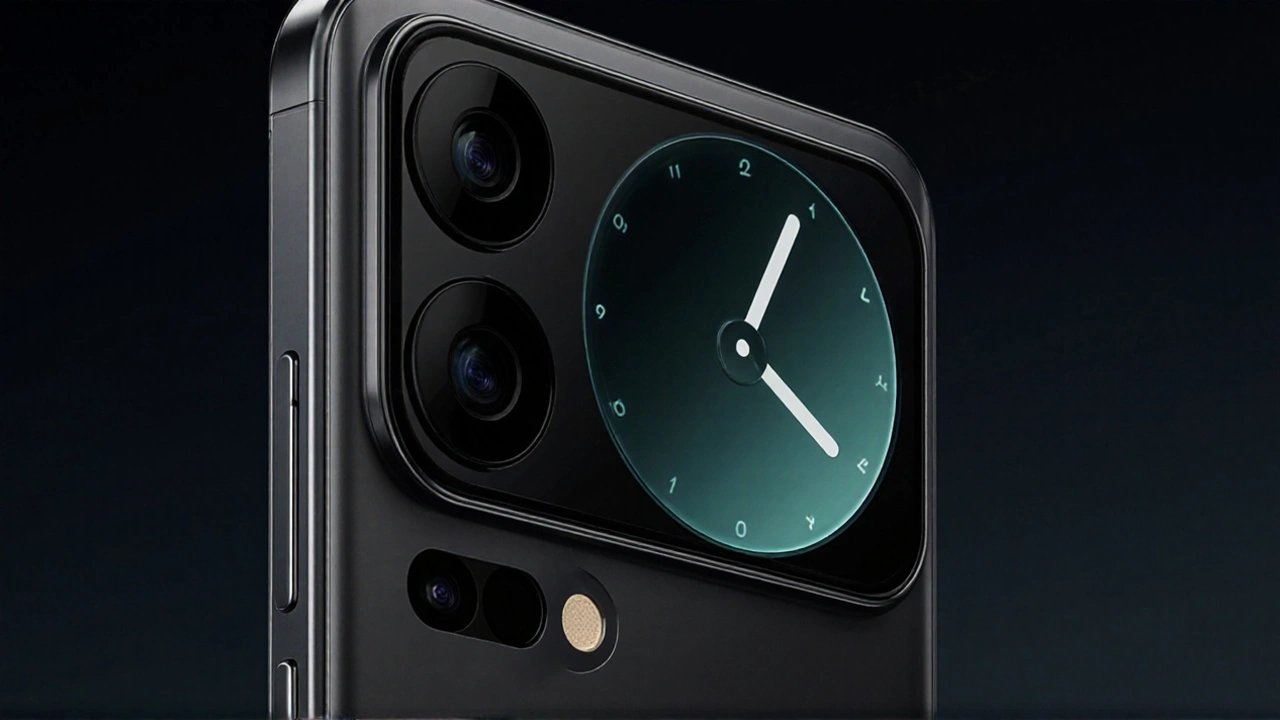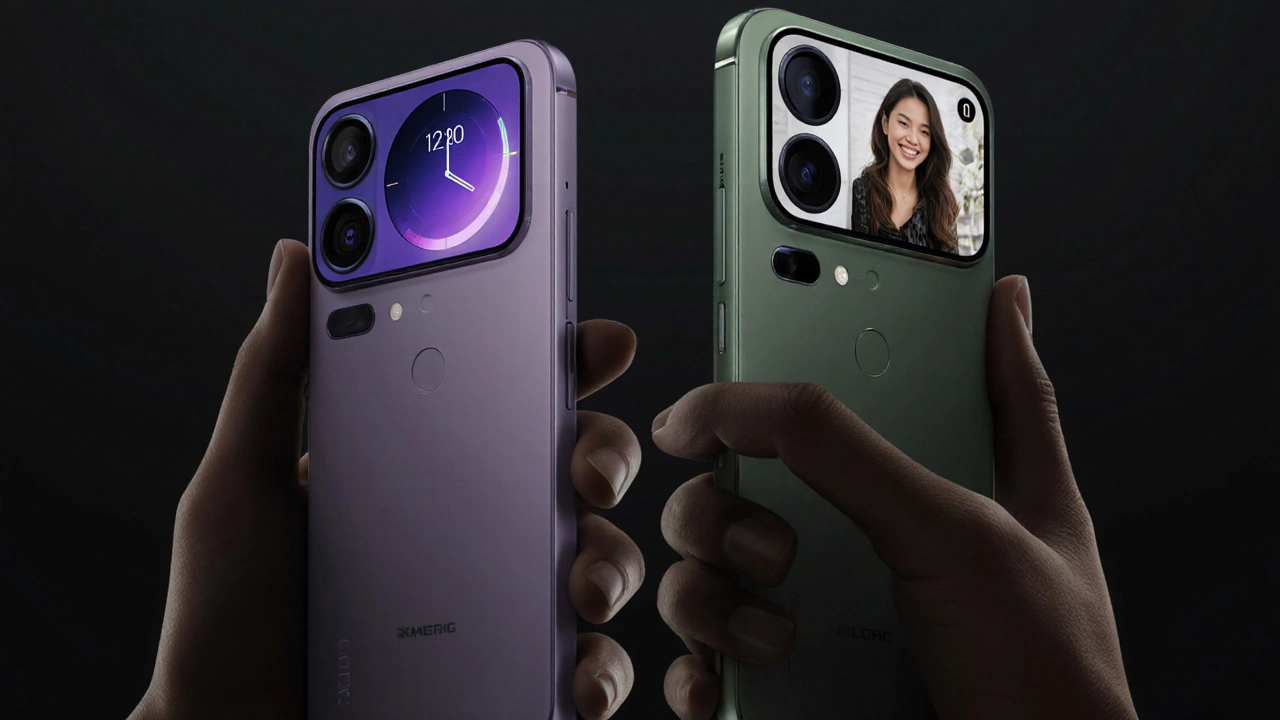
Xiaomi just dropped its newest flagship line and it’s a real head‑turner. The Xiaomi 17 Pro arrives with a second screen slapped onto the back of the phone, a top‑tier Snapdragon 8 Elite Gen 5 chip and batteries so big they could power a small laptop. While Apple and Samsung are still pushing incremental upgrades, Xiaomi is betting on fresh design and raw power to win over fans who want more bang for their buck.
Dual‑Screen Innovation
Think of the rear display as a mini‑screen that lives inside the camera module. It’s not just a novelty; Xiaomi markets it as a selfie viewfinder, a gaming HUD, a widget hub and even a tiny media player. The idea mirrors the cover display on Samsung’s Galaxy Z Flip, but instead of a folding phone you get a solid slab with a pop‑up secondary panel.
To prove the point, Xiaomi unveiled a Gameboy‑style case that clips onto the back and lets you play retro titles on the 1.2‑inch screen while the main display stays free for notifications. Imagine scrolling through Instagram on the front, then flipping the phone over to snap a perfect selfie using the rear screen as a live preview.
Practical uses include:
- Quick selfie framing without turning the phone around.
- Checking calendar events or weather while your main screen shows a video.
- Accessing interactive widgets – music controls, fitness stats, or smart home toggles – at a glance.
- Gaming on a dedicated low‑latency area that doesn’t drain the larger display.
The dual‑screen concept also opens doors for developers to craft new app experiences, though it will take time for the ecosystem to catch up.

Power, Performance and Camera
Under the hood sits the Snapdragon 8 Elite Gen 5, the first phone to launch with this chipset. It promises a bump in AI processing, better GPU performance for gaming and an efficiency edge that helps the huge batteries last longer. Xiaomi paired the chip with 12 GB or 16 GB of RAM depending on the variant, so multitasking feels smooth even when you’re juggling heavy apps.
The battery story is where Xiaomi really tries to outmuscle its rivals. The standard 17 Pro carries a 6,300 mAh cell, while the Pro Max ups the ante to a massive 7,500 mAh unit. Both support 100 W wired fast‑charge – you can go from 0 to 80 % in about 25 minutes – and 50 W wireless charging, which is rare at this capacity level.
For comparison, leaked specs suggest the iPhone 17 Pro will have a 4,252 mAh battery and the Pro Max around 5,088 mAh. That puts Xiaomi’s power density well ahead of the competition, especially for users who spend most of the day on video calls, streaming or gaming.
The displays keep the premium feel: a 6.3‑inch LTPO OLED on the base model and a 6.9‑inch version on the Pro Max, both with adaptive refresh rates up to 120 Hz. Despite the larger batteries, the 6.3‑inch phone weighs just 191 grams, making it feel lighter than the iPhone 17 Pro despite more juice inside.
Photography stays a strong suit thanks to Xiaomi’s ongoing partnership with Leica. Both phones sport a triple‑camera stack, each sensor clocking in at 50 MP, and a 5× optical zoom lens. Leica‑tuned color science and a suite of shooting modes – from classic monochrome to ultra‑wide night mode – give the device a versatile toolkit for serious shooters.
Key specifications at a glance:
- Chipset: Snapdragon 8 Elite Gen 5.
- Battery: 6,300 mAh (17 Pro) / 7,500 mAh (Pro Max).
- Fast charging: 100 W wired, 50 W wireless.
- Rear secondary display: 1.2‑inch OLED in camera module.
- Camera: Triple 50 MP + 5× optical zoom, Leica partnership.
- RAM/Storage: 12 GB/256 GB or 16 GB/512 GB options.
Pre‑orders opened in China on September 26, 2025, with shipments slated to start the next day. International rollout is still vague – analysts whisper about a possible European debut at Mobile World Congress in February 2026, perhaps alongside a rumored 17 Ultra model.
In the United States, ongoing trade restrictions keep Xiaomi phones off the market for now, and the company’s U.S. website lists no smartphones at all. That means American fans will have to wait or turn to gray‑market imports if they want the dual‑screen experience.
From a market perspective, Xiaomi is aiming straight at Apple and Samsung’s premium segment. The pricing strategy, while not disclosed fully, is expected to undercut the iPhone 17 Pro and Galaxy S 35 series, offering similar or better hardware for less cash. If the dual‑screen gimmick catches on and the battery life lives up to the specs, the 17 Pro line could become a serious contender for anyone who wants flagship performance without the brand‑premium price tag.
September 29, 2025 AT 12:50
i dont get why everyone is so hyped about a second screen. like... what am i supposed to do with it besides check the time? its not like im gonna play gameboy on my phone while scrolling ig
September 30, 2025 AT 06:59
american companies are scared because china finally built something that actually works. apple and samsung are still selling you the same phone from 2020 with a new color. this is innovation. get over it.
September 30, 2025 AT 11:37
this phone look like a toy. why you need two screen? one screen enough for everything. nigeria phone better than this.
October 1, 2025 AT 06:39
so now we’re paying $1500 for a phone that doubles as a nightstand decoration? cool.
October 2, 2025 AT 08:28
The real win here isn't the screen or the battery - it's the fact that someone finally stopped chasing incrementalism. This is what happens when you stop trying to look like Apple and start building for actual human needs. The secondary display isn't a gimmick - it's a new input layer. Developers will catch up. The ecosystem will adapt. We've seen this before with touchscreens. This is the next step.
October 2, 2025 AT 19:17
I mean... I get the appeal of the dual screen, but I also can't help but think about how many people are just gonna end up using it as a fancy notification light. Like, I'm already overwhelmed by my phone's current interface - now I'm supposed to manage two? And don't get me started on the weight distribution. I can already picture people dropping it trying to flip it around mid-scroll. The battery life sounds insane though - 7500mAh? That's wild. I'd buy it just for the charging speed alone. But I'm not convinced the extra screen adds enough value to justify the complexity. Maybe I'm just old.
October 4, 2025 AT 18:02
the dual screen is a distraction. you know who else pushed secondary displays? nokia with their 3650. it failed. apple didn't do this because they know better. also... 100w charging? that's a fire hazard waiting to happen. and leica? lol. they just slapped a logo on a sensor. this is all just chinese propaganda disguised as innovation 😏
October 5, 2025 AT 17:49
The battery size is impressive but I wonder how much of that is just dead weight. If you're carrying a brick with a screen on the back, are you really saving time or just creating more friction in daily use? The camera specs are solid, sure, but innovation shouldn't mean complexity for complexity's sake.
October 7, 2025 AT 17:41
im so ready for this i dont even care about the second screen honestly the battery and charging is what matters and the leica cam is legit i mean look at those sample pics
October 9, 2025 AT 08:15
i just wonder how many people actually use the second screen for anything real like do people really check weather on it or is it just for showing off
October 10, 2025 AT 19:14
this is what happens when you let engineers design phones instead of humans. you want a second screen? buy a tablet. you want a gameboy? buy a gameboy. stop forcing tech on people who just want to take pictures and not carry two devices in one. this is the end of mobile dignity.
October 11, 2025 AT 16:06
this is the beginning of the end. you think this is innovation? wait till the secondary screen gets hacked to display ads or track your eyeballs. you think they're not monetizing your glances? this is surveillance with a prettier face. and 7500mah? that's not a battery - it's a power bank with a phone attached. 🤡
October 13, 2025 AT 08:41
i love how the american tech media acts like this is some alien tech. bro we had foldables in 2019. this is just a different shape. also - gameboy case? cute. but i'm not paying $1200 for nostalgia. i'll just use my Switch.
October 13, 2025 AT 09:46
why does everyone act like this is the future when its just a phone with a sticker on the back
October 14, 2025 AT 04:59
I think this is actually really cool. The battery alone makes it worth it for anyone who's tired of charging every 3 hours. And the dual screen? It's not for everyone, but if you're the kind of person who multitasks with your phone - like checking messages while watching a video - this could be a game changer. Don't knock it till you try it.
October 14, 2025 AT 18:37
this is the ultimate power user device. 100w charging + 7500mah + snapdragon 8 elite gen 5 = you can literally run a full workstation on this thing. the dual screen? it's not a gimmick - it's a secondary render target. devs will build immersive workflows around this. think discord + spotify + notes all active at once. this is the future of mobile productivity. 🚀
October 16, 2025 AT 08:20
everyone's acting like this is revolutionary but let's be real - it's just a phone with a bigger battery and a screen that looks like a smartwatch. and yet somehow we're supposed to be amazed? i miss when phones were just phones.
October 17, 2025 AT 23:07
im just wondering if the second screen gets hot when your phone is charging and if its gonna crack after a few months
October 19, 2025 AT 07:23
I think this is actually kind of beautiful. Not because it’s flashy, but because it dares to be different. We’ve been stuck in this loop of bigger screens, better cameras, slightly faster chips - and no real creativity. This phone says, ‘What if we didn’t just make the screen bigger, but made the experience broader?’ It’s not perfect, and it might not work for everyone - but it’s a conversation starter. And sometimes, that’s more valuable than another 1% improvement in battery life.






September 28, 2025 AT 00:11
This dual-screen thing is either genius or a gimmick. I'm leaning toward gimmick.